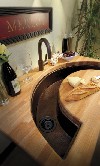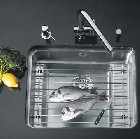
That's Entertainment
The old saying, “There’s too many cooks in the kitchen,” no longer rings true for American kitchens, as they have evolved into the most popular room in the home.With this increased popularity, watch for today’s consumers to take on kitchen remodeling projects with an eye toward increasing their entertainment space.
A fourth-quarter Home Design Trends Survey from the American Institute of Architects (AIA) took a look at future kitchen trends with input from its residential architects. “There is a strong desire to integrate the kitchen with living space that allows for a more open home environment with the ability to converse and access entertainment options while in the kitchen,” writes AIA Chief Economist Kermit Baker, PhD, Hon. AIA, in the study’s summary.
What this means specifically for the kitchen sink market is not only more sinks in general, but more multifunctional sinks and workstations.
Island Paradise
Single-family homes are getting larger. The average-size home most of us grew up in were around 2,000 square feet. Now, builders are starting at 3,600 square feet.“When you talk about entertainment space, you’re talking about the kitchen. And as kitchens get larger, so do kitchen islands,” says Michael Fotiades, director of operations for Clarke Distribution Corp., a family-owned luxury product distributor serving New England. He points out that in the past, a single person prepared and cleaned up after a meal, but now spouses and friends will work together in the kitchen to prepare the food.
“Nowadays, a party revolves around the preparation of food, the eating of the food, the talking about the food, and the clean-up afterward. It’s a European trend that has made its way over.”
The AIA survey reported that 43 percent of architects rated “island work areas” as a popular request of homeowners. These islands almost always include a secondary sink, but they aren’t your mom’s traditional-shaped, use-all appliances of the past.
“In a modern kitchen, homeowners request one sink for workhorse cleaning, the island sink for prep, and even a third sink for the increasingly popular butler’s pantry for drink service and wine stations,” Fotiades explains (more on butler’s pantries below). “The islands being installed today are not only larger, they’re more elegant.”
That can best be illustrated by the rise in oblong or trough sinks. Products such as Elkay Mfg.’s Mystic stainless-steel sink, which winds in a gentle slope down the length of a countertop, offers a bit of whimsy to a space.
Native Trails, a manufacturer of hand-hammered basins, tubs and accessories, offers its new Luna copper basins that feature an arched form, which gives the user workspace in the front of the sink, and accessible sides for guests or kitchen helpers.
Its entertainment value for prep work in the kitchen or for bar duty is achieved by its measurements: 38 inches by 18 inches overall, with trough dimensions 6 inches wide and 6 inches deep. It has two drains for easy emptying of ice and running water.
The Butler Does It
The butler pantries from the 1920s and 1930s are back by popular demand in many new home construction designs. In the AIA survey, “increased pantry space” came in as the second most popular kitchen trend at 64.2 percent. (Only “upper-end appliances” was higher with 65.2 percent.) The butler’s pantry represents a true devotion to entertainment stemware and dinnerware storage, as well as everyday tandem use.The space usually features a smaller, round sink, and possibly a wine cooler and secondary dishwasher. “They’re a status symbol for today’s homeowner,” says Fotiades, who tells us that 20- to 35-year-old homeowners feel a sense of entitlement in their homes nowadays, to have the things their parents had to wait until their 50s to acquire.
The increased storage and functionality also represents homeowners’ desire to keep organized and clutter-free in their lives. As the “cocooning” trend continues and consumers prefer to stay close to home, inspiration for home remodeling comes from resort destinations or posh hotel suites where kitchens are integrated into living areas.

Style & Functionality
As for overall look and design, the No. 1 choice in finish by far for kitchen sinks remains stainless steel. Popular undermount designs offer increased functionality, as food and waste can be wiped into the sink and disposer.And the deeper the better for most consumers. “Customers are going for deeper sinks rather than wider, more traditional 36-inch sinks,” says Fotiades, who names the most popular dimension in the Clarke showroom as 27 inches by 18 inches by 9 inches.
Single-basin requests, too, are gaining on double- or triple-basin sinks due to their ability to do more than one job.
“One single-basin sink at 36 inches would be too much. It loses its functionality, and functionality is important,” Fotiades says about the new dimensions. “It has to do more than just wash dishes.”
Sink Integration
Multifunctional or integrated work centers also are becoming popular in today’s kitchens as America’s interest in cooking continues to climb. For “performance” kitchens and décor leaning toward a commercial look, offerings such as KWC’s Waterstation makes the sink a multifunctional food prep location. It features freely rotating individual functions and accessories such as baskets, bowls, colanders, cutting boards, etc. - an absolute must for sinks today, according to Fotiades - all concentrated around a central point of water delivery.Trend Watchers
As a plumbing professional, it’s important to stay ahead of the curve - and your increasingly educated customers - when it comes to design trends and new technology. If contractors can’t get to trade shows every year, Fotiades encourages plumbing business owners to watch consumer trends through magazines, television and the Internet - mostly because that’s where their customer is getting his information, too.And the consumer is demanding better products.
“A plumber’s credibility stems from the products he installs. If he installs a faucet or sink that two months later doesn’t work, the customer won’t blame the manufacturer; he’ll blame the plumber who suggested the product in the first place,” Fotiades says.
He also suggests plumbers without their own showroom develop a relationship with a retail salesperson, so customers get a chance to touch and feel products and be confident in their purchase.
“As a service business owner, you want to provide added value, and offering well-made, leading-edge-designed products is key to that value,” Fotiades concludes.
The full 4Q Home Design Trends Survey can be found through the AIA Web site: www.aia.org.